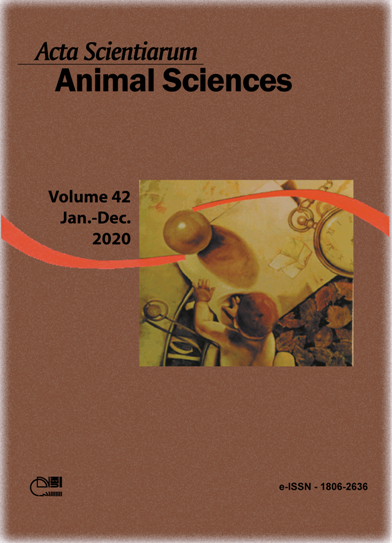Investigating the performance of polyester microfibers in situ bags using different weft yarn count and density
Abstract
Microfiber fabrics are more efficiency in retaining fine-particles that increase the variation in in situ degradability. The aim of this was to examine the performance of in situ bags made from different microfiber fabric for meeting the required specification and their ruminal degradability compared with standard Ankom in situ bags. Four fabrics were manufactured using polyester microfiber with 1.04 denier, weft yarn counts (150 and 300), weft density (22 and 28 picks / inch), plain 1/1 textile structure. Physical and mechanical properties of manufactured fabrics were measured before and after incubation. Ruminal degradability was measured for three feedstuffs (soybean meal, wheat bran and berseem hay) using three rumen-fistulated rams as a replicates after 24 and 48 hours. Fabric's pore size was significantly decreased as either yarn weft count or density increased. Yarn weft count had a significant effect on all fabric's properties. Air permeability was significantly decreased as fabric's weft yarn count increased. Sample (1) meet the specific requirements for in situ bags and showed the nearest degradability values to those observed using Ankom bags for all feedstuffs in most incubation times. Microfiberin situ bags could be used in in situ ruminal degradation trials to reduce the variation in results due to the present of the fine particles.
Downloads
References
Aboamer, A. A., El-sayed, H. M., Abo el-nor, S. A. H., Khorsed, M. M., Kholif, A. M., & Saleh, H. M. (2015). Synchronous least-cost ration formulation for lactating barki ewes using nonlinear programming. Journal of Animal Production Advances, 5(8), 733-746. doi: 10.5455/japa.20150816041529
Aboamer, A. A., Khattab, M. S. A., Abo el-nor, S. A. H., Saleh, H. M., Kholif, A. M., & Khattab, I. M. (2017). A study of nutrient digestibility, milk production and performance of lactating barki ewes fed synchronous least cost ration. International Journal of Dairy Science,12. 114–121. doi: 10.3923/ijds.2017.114.121
Adesogan, A. T. (2005). Effect of bag type on the apparent digestibility of feeds in ANKOM Daisy II incubators. Animal Feed Science and Technology, 119(3-4), 333–344. doi: 10.1016/j.anifeedsci.2004.09.012
Kuwahara, F. A., Souza, G. P., Ferreira, R. P., Costa, C., & Meirelles, P. R. L. (2016). Evaluation in situ digestibility of alfalfa indifferent grinds and textiles. Acta Scientiarum. Animal Sciences, 38(1), 37-43. doi: 10.4025/actascianimsci.v38i1.28867
Al-ansary, M. A. R. (2012). The influence of number of filaments on physical and mechanical characteristics of polyester woven fabrics. Life Science Journal, 9(3), 79–83, 2012.
Babaarslan, O., &Haciogullari, S. Ö. (2013). Effect of fibre cross-sectional shape on the properties of POY continuous filaments yarns. Fibers Polymers, 14, 146–151. doi: 10.1007/s12221-013-0146-z
Bogoro, S., Kalla, D. J. U., & Gaiya, O. (2006). Effect of positioning of feed samples in two segments of the rumen on in-situ degradability of feed stuffs. Pakistan Journal of Nutrition, 5(2), 152–155. doi: 10.3923/pjn.2006.152.155
Khadem, A. A., Pahlavan, M., Afzalzadeh, A., & Rezaeian, M. (2007). Effects of live yeast saccharomyces cerevisiae on fermentation parameters and microbial populations of rumen, Total tract digestibility of diet nutrients and on the in situ degradability of alfalfa hay in iranianchall sheep. Pakistan Journal of Biological Sciences, 10, 590-597.
Mabjeesh, S. J., Cohen, M., & Arieli, A. (2000). In vitro methods for measuring the dry matter digestibility of ruminant feedstuffs: Comparison of methods and inoculum source. Journal of Dairy Science, 83(10), 2289–2294. doi: 10.3168/jds.s0022-0302(00)75115-0
Ørskov, E. R., Hovell, F. D., & Mould, F. (1980). The use of the nylon bag technique for the evaluation of feedstuffs. Tropical Animal Production, 5(3), 195-213.
SPSS Inc. (2016). IBM SPSS Statistics for Windows, Version 24.0. Armonk, NY: IBM Corp.
Valente, T. N. P., Detmann, E., Queiroza, A. C. D. E., Valadares Filho, S. D. E. C., Gomes, D. I., & Figueiras, J. F. (2011). Evaluation of ruminal degradation profiles of forages using bags made from different textiles. RevistaBrasileira de Zootecnia, 40(11), 2565–2573. doi: 10.1590/s1516-35982011001100039
Valente, T. N. P., Detmann, E., & Sampaio, C. B. (2015). Review: Recent advances in evaluation of bags made from different textiles used in situ ruminal degradation. Canadian Journal of Animal Science, 95(4), 493–498. doi: 10.4141/cjas-2015-100
Vanzant, E. S., Cochran, R. C., & Titgemeyer, E. C. (1998). Standardization of in situ techniques for ruminant feedstuff evaluation. Journal of Animal Science, 76(10),2717-2279. doi: 10.2527/1998.76102717x
Wilman, D., & Adesogan, A. A. (2000). Comparison of filter bag methods with conventional tube methods of determining the in vitro digestibility of forages. Animal Feed Science and Technology, 84(1-2), 33–47. doi: 10.1016/s0377-8401(00)00110-3
DECLARATION OF ORIGINALITY AND COPYRIGHTS
- I Declare that current article is original and has not been submitted for publication, in part or in whole, to any other national or international journal.
The copyrights belong exclusively to the authors. Published content is licensed under Creative Commons Attribution 4.0 (CC BY 4.0) guidelines, which allows sharing (copy and distribution of the material in any medium or format) and adaptation (remix, transform, and build upon the material) for any purpose, even commercially, under the terms of attribution.
Read this link for further information on how to use CC BY 4.0 properly.








































